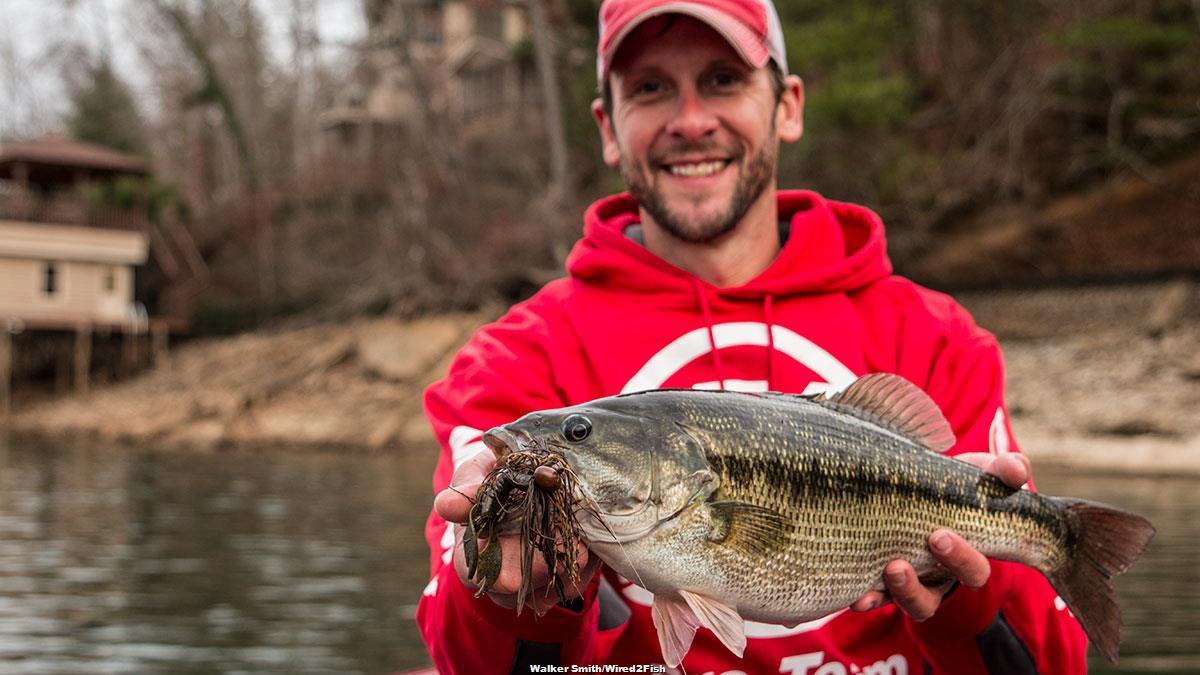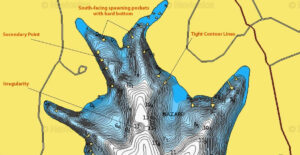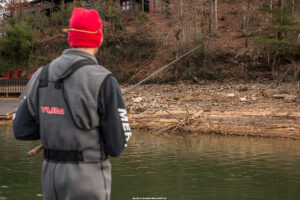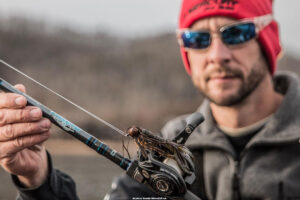Although much of the country is still dealing with lingering winter weather, make no mistake about it—the prespawn period isn’t too far away. As big female bass slowly make their way from their deep wintering holes to more predictable shallow-water staging areas, anglers are given a unique opportunity to catch loads of giant bass.
Many of us have been taught to “follow” these prespawners throughout their late-winter journey. It’s the ordinary stuff we’re used to reading—find ‘em in their wintertime homes and simply stay on top of them as they make their migration. It sounds great, but it’s often easier said than done.
What if, however, we took an alternate approach and looked at things from a different angle? Instead of working from the outside-in to find early prespawners, why not start your dissection from the inside-out?
That’s exactly what professional angler Patrick Bone does. This strategy offers two primary advantages—it helps him keep these ever-changing bass “honest” while staying ahead of their migration routes.
First things first: What makes a good spawning pocket?
For most of us, it’s a bit odd to be thinking about spawning grounds in the late-winter months. It’s still cold, a percentage of the bass are still deep and at first glance, it seems like they’re nowhere near that magical time. But according to Bone, identifying suitable spawning grounds is the first ingredient to getting on a rock-solid prespawn pattern.
“In order to locate the bass this time of year, it’s essential to understand and locate prime spawning areas,” Bone said. “We all know they’re eventually going to spawn. That’s not some giant secret. So if you can pinpoint their eventual destination, you’re going to have a much easier time intercepting them during the prespawn period.”
We often fall into the mindset that, if we can find shallow water in the spring, we’ll find the bass. This might be true to an extent, but your odds increase considerably if you’re able to delve a bit deeper into their specific preferences.
- South-facing pockets— “When I’m just beginning to put a prespawn pattern together, I’m going to grab a paper map and locate every south-facing pocket,” Bone said. “These areas will be the basis of my strategy because they receive the most sunlight throughout the day, resulting in warmer water temperatures. The bass will slowly be making their way towards these areas.”
- Bottom composition— Once he locates several south-facing pockets, Bone’s attention turns to bottom composition. While you may eventually find a few bass spawning in silted-in pockets with a mushy bottom, he makes an effort to find more suitable areas adorned with gravel, sand or even clay.
- Stability— “Now that I’ve found some south-facing pockets with a hard bottom composition, I’m going to narrow my approach even further by finding stability,” Bone said. “In other words, I don’t want to put much effort into areas with a large feeder creek because these late-winter weather fronts can dump a bunch of fresh mud into the pockets which can be a major turn-off for bass. The less water that comes into the back a particular pocket, the more stable the water levels, temperature and color will be.”
Follow the tight contour lines in reverse
After indentifying the most high-percentage spawning areas on a body of water, Bone will begin to work backwards along the bass’ migration routes. Although it’s a different approach compared to many others, this strategy allows him to stay on top of any curve balls the fish might throw his way.
“The majority of anglers are usually behind the fish,” Bone said. “I can’t tell you how many times this used to happen to me—I’d miss out on some of the best action of the year. Throughout the prespawn period, bass can be in 20 feet of water one day and in 3 feet the next, so I prefer to start my dissection in shallow water. The fish may not be there yet, but this keeps ‘em honest. There’s always a chance you can run across a giant wad of shallow fish before anyone else figures it out and when this happens, you’ll have the day of a lifetime.”
- Tight contour lines— Bone looks for tight contour lines leading to and from the bass’ eventual spawning grounds. These tight lines are indicative of deeper water and a dramatic depth change and are often found in the form of ditches and drains, which serve as major highways for migrating bass. Just like deer and other wildlife follow funnels to and from foodsources, bass will follow these tight contours because they’re often the path of least resistance.
- Contour irregularities— “As the bass follow these tight contour lines, they’re likely to stop on any irregularities,” Bone said. “So you need to look for anything different, whether it’s a small underwater point protruding from a steep depth change or an indentation, such as a creek channel or drain bend. If you notice the contour lines getting wider—indicating a flat bottom—along these tight contours, you’ll probably find a few bass nearby.”
- Tight contours offer adaptability— Even the smallest weather fronts can throw a major wrench in the plans of prespawn bass. Ironically, the late-winter and early spring months are well known for their crazy, unpredictable weather. In addition to acting as an easy migration route for prespawners, these tight contour lines also give them the ability to adapt to weather changes quickly. If an area is fairly flat, the bass will need to swim a healthy distance to reach more comfortable conditions. Tight contours, however, allow the bass to easily move vertically throughout the water column to change depth.
Likely prespawn targets
If you’ve followed Bone’s guidelines up to this point, you’ve essentially eliminated a great deal of on-the-water legwork and unproductive water without even leaving your house. Instead of spending a full day of haphazardly searching for likely prespawn areas, you’re now able to concentrate on high-percentage areas from the moment you hit the lake.
The third and final step to this process revolves around finding specific, fish-holding cover along the natural funnels represented by these tight contour lines. To simplify things, Bone breaks down late-winter and early spring into two categories—early prespawn, when the water temperatures hover between 48 and 52 degrees and prespawn, when water temperatures rise above the 52-degree mark.
- Early prespawn— “When the water temperature is between 48 and 52 degrees, you’ll have a lot of success targeting docks, laydowns and stumps adjacent to deep water,” Bone said. “Whenever I find a shallow bank with tight contour lines nearby, I’ll target cover in the 15-foot range with one of two baits—a 1/2-ounce Booyah Pigskin Jig or a Bomber Deep Diving Square Bill crankbait. This is when you’ll start to see a lot of fish stack up on the steeper sides of secondary points, which are basically rest areas along the migratory highways we discussed. If I can’t get bit in deeper water, I’ll throw a Smithwick Elite 8 Rogue jerkbait on top of the point, especially when they’re sunning in shallow water on bluebird days.”
- Prespawn— If the water temperatures are above 52 degrees, you can fully expect to have a lot of fun. Following the tight contour lines, Bone will put his trolling motor on high-speed and cast to any and everything that stands between seconday points and his previously located spawning pockets—there’s nothing fancy or overly technical to his approach. Whether it’s docks, grass lines or simply a twig in the water, he’ll use an XCalibur XCS 100 Square Lip crankbait and a Booyah Blade Double Willow Spinnerbait to quickly and efficiently cover water.
When the weather breaks and you begin targeting prespawn bass, don’t assume that you need to start in the stereotypical areas. If you spend a bit of time doing some map study and finding their eventual spawning destinations, there’s a great chance you might intercept the prespawn mother lode before anyone else finds ‘em.















